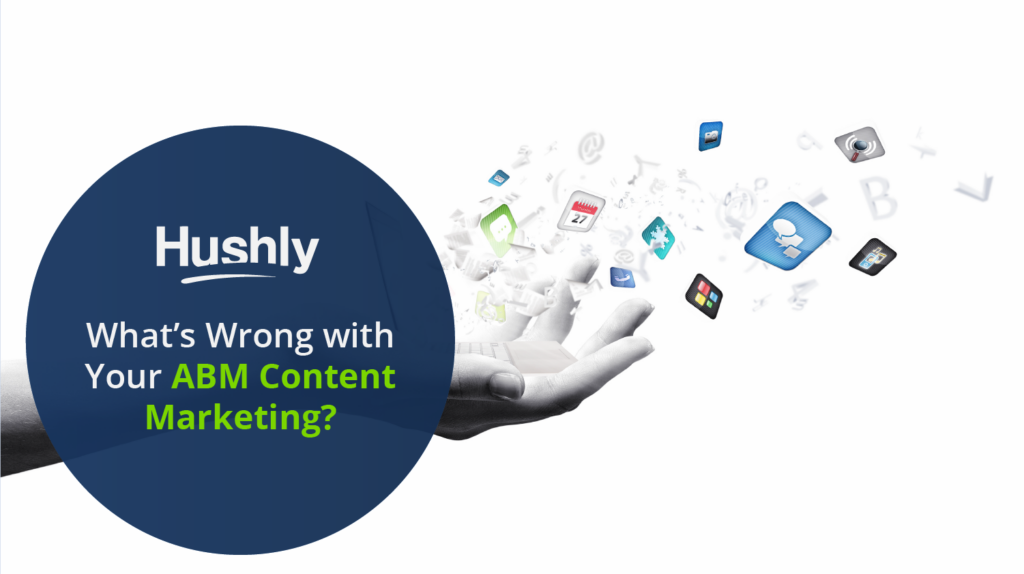Content is an essential component of every successful account-based marketing strategy.
You need ABM content marketing to:
- Familiarize key accounts with your company, product/services, and culture.
- Demonstrate your industry authority and expertise.
- Empower leads to solve problems, research, and address pain points.
- Help customers use your product/services and solve problems as they arise.
Since content is so vital to the ROI and success of your ABM strategy, it’s important to take your content marketing strategy seriously as well.
Less than half of B2Bs classify their content marketing as “sophisticated.” However, 92% of B2Bs say they’re running an ABM strategy. This implies that plenty of organizations are relying on generic, low-quality, or unfocused content to fuel their ABM – not good.

7 Mistakes Holding Back Your ABM Content Marketing Results
Ten years ago, ABM wasn’t available to small startups and mid-size companies. Most companies have only had ABM strategies in place for less than five years.
Five years is nowhere near enough time to structure, launch, and fully optimize your ABM content marketing. Even tech giants like Microsoft still adjusts, changes, and updates to their ABM strategies and tactics.
1. No Coherent and Scalable Strategy
Only 21% of B2Bs with the least successful content marketing have a documented strategy. However, 60% of B2Bs with high-performing content definitely do.
A documented strategy is crucial for ABM content marketing success because so much hinges on research. Specifically, your strategy must explain in detail who you’re targeting, keywords, pain points, promotion channels, and more.
An editorial calendar is essential for bringing your content marketing strategy to life. Only half of B2Bs with low-success content marketing use an editorial calendar but a whopping 80% of high-performers do.
Your editorial calendar puts your content strategy into action.
Make sure your content marketing strategy is scalable too. Once you publish content and track your ABM results, you’ll need to pivot and adapt. Certain accounts and roles will require more attention, others less.
2. Unclear ABM Content Marketing Goals
You should already have goals mapped out for your general ABM strategy. However, you can’t just transfer them over to content marketing and hope to deliver ROI.
Everyone wants more leads and sales. Those goals aren’t specific enough to drive a successful ABM content marketing strategy.
Consider your distinct goals for each account, stage of the journey, and role when you create every piece of content. What action do you want the reader/viewer/listener to take after consuming each piece of content?
3. Creating the Wrong Types of Content for Each Segment
Even within each account, different roles need specific types of content at each stage of the buyer’s journey. Unfortunately, 66% of buyers say companies already provide too much content and most of it is totally useless.
Buyers need content that empowers them. They definitely don’t want product promotions, long-form content, and sales pitches.
Instead, focus on product comparisons, podcasts, videos, and concise eBooks. Do your research though. Figure out who you’re targeting within each account and what type of content they’d prefer.
Your goal is to make their job easier through content.
4. Neglecting Pain Points in Your ABM Content Marketing
How can you show accounts that your organization is capable of solving their problems? ABM content marketing solves their problems.
68% of buyers say they’d like to see content organized by pain point on your website so it’s easy to find exactly what they need seamlessly.
Use your content to give away your expertise and advice. Every organization has individual experts in certain fields. Put their experience and skill into your content.
Keyword research is useful for identifying pain points and problems. Long-tail keywords are especially handy for understanding the context behind each search.
Platforms like LinkedIn, Reddit, Quora, and other forum-type websites – especially anonymous ones – offer a glimpse into the mind of your target audience segments. Look for ways to apply the research to your ABM content.
5. No Personalized and Interactive Interface
Your accounts simply don’t have time for generic and unengaging content.
Leads don’t want to search through your blog and landing pages for something relevant. They know the technology exists to create a hyper-personalized content recommendation experience and they expect you to deliver it.
It’s no surprise that nearly 70% of B2Bs say they expect an Amazon-like experience from business websites.
Your content experience should offer personalized content recommendations based on browsing behavior and intent data. Interactive elements are important too for encouraging engagement and spending more time on your site.
6. Untargeted and Generic Landing Pages
Traditional landing pages just don’t work for ABM: They’re static and purposely generic to appeal to a wide audience.
Instead, use dynamic technology to offer a personalized experience. Hushly’s special ABM tool, for example, lets you design hyper-personalized landing pages for each account complete with their logo, branding, content, and unique offers.
Artificial intelligence detects which account each visitor belongs to and provides them a personalized landing page.
7. Gating All Your ABM Content Marketing
When you fully gate all your content, everything you’ve invested into your ABM content marketing goes to waste.
Not everyone is prepared to hand over their email address the first time they interact with your brand. They need some convincing first if you want to earn a spot in their valuable inbox real estate.
How can they learn to trust your business if they can’t consume any of your content?
Instead, either allow your visitors to consume all your content freely or offer decent samples so they can see what they’re getting before they commit. You can still collect emails but with much smaller (and smarter) microforms and your leads won’t feel bribed into providing their contact info.
Give Each Account the Personalized Web Experience They Expect
When accounts arrive at your website, what type of experience do you provide? Do you offer dynamic content personalized for every account or generic content for different industries?
Hushly’s platform accelerates your ABM content marketing with a hyper-personalized and interactive experience for each visitor. Instead of traditional landing pages, Hushly pages detect the specific company of each visitor to provide personalized branding, content marketing, promotions, and other tools.
Learn how Hushly’s innovative ABM-specific dynamic landing pages work.




